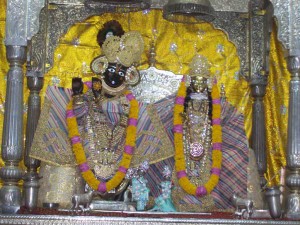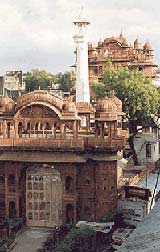Tourist Attraction of Ajmer
South west of Jaipur, Ajmer is an oasis wrapped in the green hills. The city was founded by Raja Ajay Pal Chauhan in the 7th Century A.D. and continued to be a major centre of the Chauhan power till 1193 A.D. Then Prithviraj Chauhan lost it to Mohammed Ghori, after which Ajmer became home to many dynasties. Today, Ajmer is a popular pilgrimage centre for the Muslims as well as Hindus. Especially famous is the Dargah Sharif-tomb of the Sufi saint Khwaja Moinuddin Chisti, which is equally revered both by the Hindus and the Muslims. Ajmer is a centre of culture and education. The British chose Ajmer for its prestigious Mayo College, a school exclusively for Indian nobility at one time. However, now it is one of the best public schools in the country. Ajmer is also the base for visiting Pushkar (14 km.) which has the distinction of having the only Brahma temple in the world. The Picturesque Pushkar Lake is a sacred spot for Hindus. During the month of Kartik (Oct/Nov), devotees throng in large numbers to take a dip in the sacred lake.
Ajmer was also a favourite residence for the great Mughals. One of the first contacts between the Mughal King Jahangir and Sir Thomas Roe took place here in 1616. The Scindias took over the city in 1818 and then handed it over to the British. Thus Ajmer was the only region to be directly controlled by the East Indian Company. The bus stand in Ajmer is located near the RTDC hotel Khadim. The railway station is further south and most of the office lies in the northeast and most of the city’s market is located behind and up to Agra Gate. Further northwest is a large artificial lake called the Anna Sagar.
SALEMABAD (NIMBARK PEETH)
Bhati chief of Khejarli Shri Sheoji and Gopal Singh Ji Bhati founded this Peeth in 1520 (1463 A.D.) following instructions of his holiness Shri Nimbarkacharya Peethadhishwara Shri Parashu Ram-Devacharya Ji. The temple has been so designed that the Deity is visible for Darshan the moment one enters the main gate.the Sanctum Sanctorum has been built in a way that the moonlight of the moon of Sharad Poornima touches the lotus feet of the idol of the Lord at 12.00 pm.In to Jagmohan of the main temple the pillars of marble are exquisitely ornamental and their middle part is transparent. This wide spreading castle like temple is built on 42 thousand square feet land.
ADHAI – DIN KA- JHONPRA
This is a masterpiece of Indo – Islamic architecture. As legend goes its was constructed in two and a-half days (Adhi-Din). It is a relic of an old mosque consisting of a quadrangle with a front screen wall of seven pointed arches. The distinct pillars and arched screen with its ruined minarets make it a splendid architectural masterpiece.
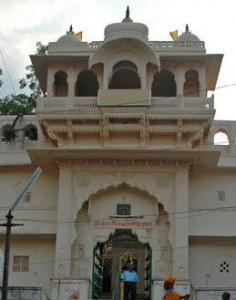
Pushkar is a sacred town for the Hindus, situated 11 kms.to the North-West of Ajmer.Evidence points to its having existed during the fourth century B.C. lake in the inhospitable surroundings of a desert is no less than a miracle.Brahma is supposed to have performed sacrifice at this lake on Kartik Purnima (the full moon day of the Kartik month), hallowing the place. Sacred to Brahma, Pushkar boasts of its temple dedicated to him, which is the only one of its kind in the world. A dip in the waters of Pushkar and worship at his temple ensure salvation. So thousands flock to Pushkar to observe the ritual on kartik Purnima, or on any of the four days preceding it.
NASIYAN (RED) TEMPLE
The red temple is a Digambar Jain temple which has a double- storey hall adjacent to the main temple. The hall displays a series of large gold plated wooden figures depicting legends from Jain mythology. The entire hall is richly adorned by glass mosaic, precious stones, gold and silver work. The place is also popularly called Soni Ji Ki Nasiyan.

Ajmer the city where the Dargah of the Great Sufi Saint Khwaja Moinuddin Chishti stands, is a sacred centre of pilgrimage. Hallowed by the memories of the great seer, Ajmer has earned the epithet of “ Madinatul Hind or the Madina of India”. Devotees of all sects and faiths come here as the saint’s blessings are infallible for all.Each year, the followers of the master congregate here from all parts of the world on the occasion of the annual festival of Urs to pay their obeisance to seek the Saint’s blessings for fulfillment of wishes.
TARAGARH FORT
The giant fort stands guarding the city. It has six gates.The fort also has Miran Saheb ki Dargha who was the governor of the fort and laid down his life in an encounter. It gives a panoramic view of the city situated in Nagpahari of Aravalli ranges, this fort has immense archaeological and historical importance.
ANA SAGAR
It is an artificial lake named after Anaji Chauhan.The catchments were built with the help of local populace. The 'Baradari' pavilions was built by Shah Jahan, to facilitate his long stays in Ajmer. the Baradari and the adjoining parks are the lungs of city and favourite outing spot.
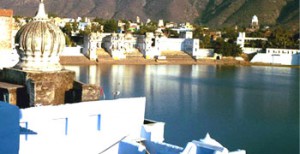
The pious Pushkar Lake is believed to have been created by the falling of a lotus from the hand of Lord Brahma. It is said to be as old as the creation itself. As per the Hindu Mythology there are Panch Sarovar (Five Lakes) namely, Man sarovar, Bindu Sarovar, Narayan Sarovar, Pampa Sarovar and Pushkar Sarovar. The lake is considered as one of the most sacred spots. The devotees believe that one dip in the waters of the lake on Kartika Poornima is equivalent to performing yagnas for several hundred years. The charming lake amidst the hills has fifty-two bathing ghats, built around the lake. The water around each ghat is supposed to have special healing power.

Lord Rangji is an incarnation of Lord Vishnu. This temple was built in 1823 AD by Seth Puran Mal Ganeriwal of Hyderabad. This temple is unique due to the confluence of South Indian (Dravidian), Rajput and Mughal styles of architecture.

The temple is located on the hill behind the Brahma temple and one has to climb a long series of steps to reach the shrine. It commands a panoramic view of the beautiful lake and the picturesque surrounding villages.
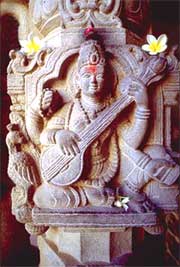
Literally her name means 'the flowing one' .In the Rig Veda she represents a river deity and is connected with fertility and purification. She is considered the personification of all knowledge – arts, sciences, crafts and skills. She is the goddess of the creative impulse, the source of music, beauty and eloquence. Artists, writers and other individuals involved in creative endeavours have for millennia come on pilgrimage to Pushkar to invoke the inspiration of Brahma and Saraswati. According to a theory,the shrine myths are often metaphorical expressions of the particular power of a pilgrimage place, The lake, hill and area of Pushkar have a pervading spirit the presence of which awakens and stimulates the human capacity for creativity.

The lakeside city of Ajmer is located in central Rajasthan, and is held in great reverence by devotees of all communities who call it 'Ajmer Sharif' (Holy Ajmer). It is here that the mortal remains of the highly respected Sufi saint Khwaja Moin-ud-din Chishti lie buried.
The Khwaja came from Persia and established the Chishti order in India. He is popularly known as Gharib Nawaz (protector of the poor) because he dedicated his entire life to the service of mankind. His spartan life spanned almost a hundred years and he embraced death in solitude while he had withdrawn to his cell for six days, asking not to be disturbed. The Dargah Sharif in Ajmer is the place where the Saint's mortal remains lie buried and is the site of the largest Muslim fair in India. More than five lakh devotees belonging to different communities gather from all parts of the subcontinent to pay homage to the Khwaja on his Urs (death anniversary) during the first six days of Rajab (seventh month of the Islamic calendar.)
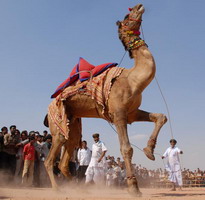
The Pushkar Cattle Fair is one of the largest in India and the only one of its kind in the entire world. During the fair, Lakhs of people from rural India flock to Pushkar, along with camel and cattle for several days of livestock trading, horse dealing, pilgrimage and religious festival.
This small town, becomes a cultural phenomenon when colourfully dressed devotees, musicians, acrobats, folk dancers, traders, comedians, ‘sadhus’ and tourists reach here during Pushkar fair. According to Hindu chronology, it takes place in the month of Kartika (October or November) beginning on ‘ashtmi’ 8th day of Lunar Calendar and continues till full moon (‘Poornima’). The camel and cattle trading is at its peak during the first half of festival period. During the later half, religious activities dominate the scenario. Devotees take dips in the holy "Sarovar" lake, as the sacred water is known to bestow salvation.
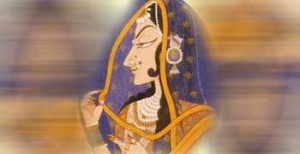 Kishangarh
Kishangarh
Kishangarh is 27 Kms north east of Ajmer and was founded by Kishan Singh, a Rathore Prince. In the 18th century, it attained fame as one of the finest schools of miniature paintings. Though a smaller school with a much shorter duration it had a more refined style. It peaked under the patronage of Savant Singh, an heir to the throne who later became a hermit. It is said that Savant Singh modelled as Krishna while his mistress nicknamed as Bani Thani modelled for Radha. Paintings of Bani Thani are most celebrated. The artists of this school favoured evening lights and grey skies with fine colours. This outstanding school lasted only a few decades. Today the artists still create reproductions of the work. Kishangarh is now an industrial town for marble and textiles. It is connected by train and bus.
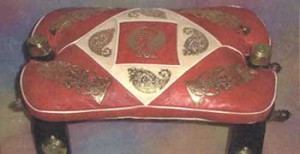
Tilonia is a small town 25 kms from Kishangarh near Ajmer and 7 kms off Jaipur-Ajmer highway. A distinctive feature of the town is Barefoot college, which began in 1972 with the conviction that solutions to rural problems lie within the community. The College, officially known as Social Work and Research Centre, addresses problems of drinking water, girl education, health and sanitation, rural unemployment, income generation, electricity and power, social awareness and the conservation of ecological systems in rural communities.

